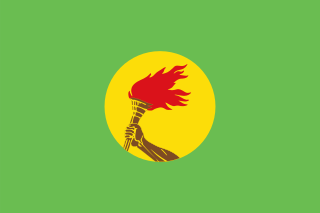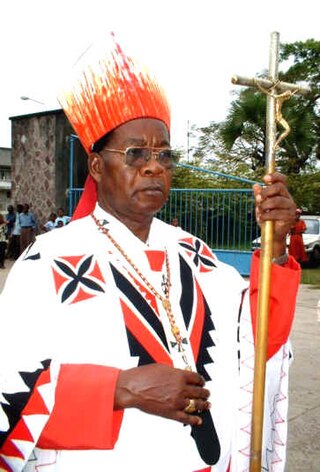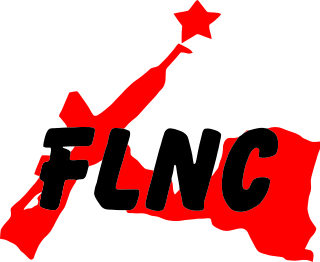
Zaire, officially the Republic of Zaire, was the name of the Democratic Republic of the Congo from 1971 to 1997. Zaire was located in Central Africa and was, by area, the third-largest country in Africa, and the 11th-largest country in the world. With a population of over 23 million inhabitants, Zaire was the most populous officially Francophone country in Africa, as well as one of the most populous in Africa.

Mobutu Sese Seko Kuku Ngbendu wa za Banga, commonly known as Mobutu Sese Seko or simply just Mobutu and also by his initials MSS, was a Congolese politician and military officer who was the 1st and only President of Zaire from 1971 to 1997. Previously, Mobutu served as the 2nd President of the Democratic Republic of the Congo from 1965 to 1971. He also served as the 5th Chairman of the Organisation of African Unity from 1967 to 1968. During the Congo Crisis, Mobutu, serving as Chief of Staff of the Army and supported by Belgium and the United States, deposed the democratically elected government of left-wing nationalist Patrice Lumumba in 1960. Mobutu installed a government that arranged for Lumumba's execution in 1961, and continued to lead the country's armed forces until he took power directly in a second coup in 1965.

The Democratic Republic of the Congo is a country in Central Africa. By land area, the DRC is the second-largest country in Africa and the 11th-largest in the world. With a population of around 112 million, the Democratic Republic of the Congo is the most populous Francophone country in the world. The national capital and largest city is Kinshasa, which is also the economic center. The country is bordered by the Republic of the Congo, Central African Republic, South Sudan, Uganda, Rwanda, Burundi, Tanzania, Zambia, Angola, the Cabinda exclave of Angola, and the South Atlantic Ocean.

The Alliance of Democratic Forces for the Liberation of Congo-Zaire, also known by the French acronym AFDL, was a coalition of Rwandan, Ugandan, Burundian, and Congolese dissidents, disgruntled minority groups, and nations that toppled Mobutu Sese Seko and brought Laurent-Désiré Kabila to power in the First Congo War. Although the group was successful in overthrowing Mobutu, the alliance fell apart after Kabila did not agree to be dictated by his foreign backers, Rwanda and Uganda, which marked the beginning of the Second Congo War in 1998.

The First Congo War (1996–1997), also nicknamed Africa's First World War, was a civil war and international military conflict which took place mostly in Zaire, with major spillovers into Sudan and Uganda. The conflict culminated in a foreign invasion that replaced Zairean president Mobutu Sese Seko with the rebel leader Laurent-Désiré Kabila. Kabila's unstable government subsequently came into conflict with his allies, setting the stage for the Second Congo War in 1998–2003.

Étienne Tshisekedi wa Mulumba was a Congolese politician and the leader of the Union for Democracy and Social Progress (UDPS), the main opposing political party in the Democratic Republic of the Congo (DRC). A long-time opposition leader, he served as Prime Minister of the country on three brief occasions: in 1991, 1992–1993, and 1997. He was also the father of the current President, Felix Tshisekedi.

Frédéric Etsou-Nzabi-Bamungwabi, C.I.C.M. was cardinal and Archbishop of Kinshasa, Democratic Republic of the Congo (DRC). He was the DRC's foremost Catholic prelate from 1991 until his death in 2007.

The Stade des Martyrs de la Pentecôte, or simply the Stade des Martyrs, is the national stadium of the Democratic Republic of the Congo (DRC), located in the Kinshasa commune of the capital Kinshasa. With a seating capacity of 80,000, it is the largest stadium in the DRC and the fourth-largest stadium in Africa. It serves as the home stadium for the Congolese football national team, AS Vita Club, and DCMP, making it the largest multifunctional venue in the country.

Jean Nguza Karl-i-Bond was a prominent Zairian politician.

Authenticité, sometimes Zairisation or Zairianisation in English, was an official state ideology of the regime of Mobutu Sese Seko that originated in the late 1960s and early 1970s in what was first the Democratic Republic of Congo, later renamed Zaire. The authenticity campaign was an effort to rid the country of the lingering vestiges of colonialism and the continuing influence of Western culture and to create a more centralized and singular national identity.

The Archdiocese of Kinshasa is an archdiocese of the Roman Catholic Church in the Democratic Republic of the Congo. Its ecclesiastic territory includes the capital city of Kinshasa and surrounding districts. The archdiocese is the metropolitan see for the Ecclesiastical Province of Kinshasa. The current archbishop is Fridolin Ambongo Besungu.

Law enforcement in the Democratic Republic of the Congo has historically been focused on furthering the state's aims with no regard for human rights. The Police nationale congolaise is the police throughout the territory of the Democratic Republic of the Congo. It was composed of between 110,000–150,000 officers as of 2010.

The Congolese National Liberation Front is a political party funded by rebels of Katangese origin and composed of ex-members of the Katangese Gendarmerie. It was active mainly in Angola and Zaire during the 1970s.
Joseph-Albert Malula was a Congolese Cardinal of the Roman Catholic Church. He served as Archbishop of Kinshasa from 1964 until his death, and was elevated to the cardinalate in 1969.

Christianity is the predominant religion in the Democratic Republic of the Congo, with Catholicism and Protestantism being its main denominations.

Democratic Republic of the Congo–United States relations are the international relations between the Democratic Republic of the Congo and the United States of America.

Democratic Republic of the Congo–Russia relations are the bilateral foreign relations between the Democratic Republic of the Congo and Russia. The Democratic Republic of the Congo has an embassy in Moscow and an honorary consulate in Yekaterinburg. Russia has an embassy in Kinshasa. The relations between the two countries were established on July 7, 1960, and restored since November 30, 1967.
The Zaire Use, also called Zairean Rite, officially the Roman Missal for the Dioceses of Zaire, is a Congolese liturgical use of the Roman Rite within the Catholic Church. Approved by the Vatican in 1988, it contains many elements from the Ordinary Form of the Roman Rite, but also incorporates elements from sub-Saharan African culture, particularly Congolese, including a number of inculturated liturgical modifications.

Emmanuel Dungia was a diplomat of the Democratic Republic of Congo (DRC) and author of the political book: Mobutu and the money of Zaïre: the revelations of a diplomat, former Secret Services agent. The latter includes the report prepared for the International Monetary Fund by Erwin Blumenthal, former Director of Foreign Affairs of the Bundesbank. Dungia was also imprisoned but was eventually acquitted by the Congolese government for his alleged involvement in a plot to overthrow Laurent Kabila who was assassinated 16 January 2001.
During the presidency of President Mobutu Sese Seko of the Democratic Republic of the Congo, later Republic of Zaire (1965-1997), social and political rights were strongly curtailed. As a consequence, several Congolese/Zairean citizens went into exile for political reasons.

















